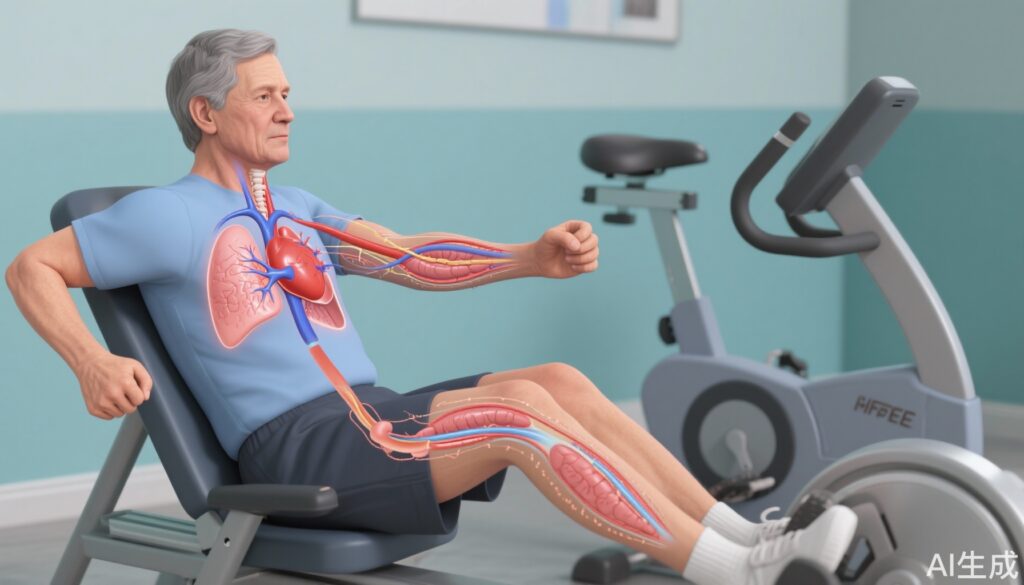Study Background and Disease Burden
Heart failure with preserved ejection fraction (HFpEF) is a complex clinical syndrome predominantly affecting older adults, characterized by symptoms of heart failure despite normal left ventricular ejection fraction. A hallmark of HFpEF is the exaggerated elevation of pulmonary capillary wedge pressure (PCWP) during exertion compared to healthy age-matched controls. This aberrant hemodynamic response contributes to exercise intolerance—a major limiting symptom affecting quality of life and prognosis in this population. Beyond cardiac abnormalities, HFpEF is increasingly recognized as a multisystem disorder involving systemic and pulmonary vascular dysfunction, alongside impairments in respiratory mechanics.
One underappreciated component in HFpEF pathophysiology concerns alterations in lung mechanics, particularly expiratory flow limitation (EFL) and dynamic hyperinflation (DH). EFL, resulting from obstructed expiratory airflow, can cause progressive increases in end-expiratory lung volume during exercise, known as DH. This phenomenon forces ventilation to occur at higher lung volumes, altering intrathoracic pressures, reducing inspiratory capacity, and potentially impacting cardiac filling pressures and overall cardiopulmonary interaction. However, the extent and clinical implications of DH and EFL in HFpEF remain incompletely understood, limiting therapeutic options targeting these lung mechanics abnormalities.
Study Design
To elucidate the relationship between dynamic lung volume changes and exercise hemodynamics in HFpEF, Leahy et al. conducted a prospective, observational study involving 55 patients diagnosed with HFpEF (mean age 71 ± 7 years, 70% female). Subjects underwent detailed hemodynamic and ventilatory assessments at rest, low-level (20-W) exercise, and peak exercise on an upright semirecumbent cycle ergometer. Right heart catheterization provided direct measurements of right atrial pressure, mean pulmonary artery pressure (mPAP), and pulmonary capillary wedge pressure (PCWP). Concomitant measurements included oxygen uptake via indirect calorimetry, cardiac output using the direct Fick method, and respiratory parameters including flow-volume loops.
Dynamic hyperinflation was rigorously defined as an increase in end-expiratory lung volume of at least 150 mL from baseline, ascertained through repeated inspiratory capacity maneuvers during exercise. This enabled classification of subjects into those exhibiting DH and those with typical lung volume responses.
Key Findings
The study revealed that patients with HFpEF who developed dynamic hyperinflation during exercise experienced significantly higher PCWP compared to those without DH. At 20-W exercise, PCWP averaged 24 ± 6 mm Hg in the DH group versus 18 ± 6 mm Hg in the typical group (P = 0.033). This divergence was even more pronounced at peak exercise, with PCWP reaching 44 ± 9 mm Hg in DH patients compared to 31 ± 6 mm Hg in those without DH (P = 0.002).
Additionally, the degree of dynamic hyperinflation correlated modestly but significantly with PCWP elevations at both submaximal and peak workloads (R2 = 0.196 and 0.204 respectively; P < 0.001), suggesting a dose-dependent relationship. Mean pulmonary artery pressure (mPAP) also showed statistically robust associations with DH (P < 0.001 at both 20-W and peak exercise).
These findings propose that augmented exercise PCWP in HFpEF is not solely attributable to intrinsic left ventricular diastolic dysfunction or stiffness, but also influenced by elevated intrathoracic pressure resulting from dysfunctional ventilatory mechanics such as DH. This mechanistic insight links respiratory-lung interaction abnormalities with central hemodynamic derangements during exertion.
Expert Commentary
The study by Leahy et al. offers critical mechanistic clarity into the cardiopulmonary interplay in HFpEF, emphasizing the importance of lung mechanics in modulating cardiac filling pressures during exercise. The reported observations challenge the traditionally held view that elevated exercise PCWP is mostly a marker of ventricular stiffness, expanding considerations to include the impact of pulmonary physiology.
Clinically, these data urge incorporation of dynamic respiratory assessments into exercise testing protocols for HFpEF patients, potentially guiding tailored interventions such as pulmonary rehabilitation or bronchodilator therapy aimed at reducing expiratory flow limitation and dynamic hyperinflation.
However, the modest strength of correlations and the cross-sectional design suggest further longitudinal research is warranted. It remains to be seen whether targeting DH can translate into tangible improvements in exercise capacity or clinical outcomes.
Conclusion
Dynamic hyperinflation during exercise substantially contributes to elevated pulmonary capillary wedge pressure in patients with HFpEF. This evidence underscores dysfunctional ventilatory mechanics as a key modifier of exercise hemodynamics and symptom burden in this complex syndrome. Therapeutic strategies addressing lung mechanics may represent a novel frontier to ameliorate exercise intolerance and improve quality of life in HFpEF. Ongoing research integrating pulmonary function insights with cardiovascular management is essential to advance care paradigms.
References
Leahy MG, Wakeham DJ, MacNamara JP, Brazile T, Abulimiti A, Hearon CM Jr, Samels M, Tomlinson AR, Balmain BN, Babb TG, Levine BD, Sarma S. Heart-Lung Interactions in HFpEF: Dynamic Hyperinflation and Exercise PCWP. JACC Heart Fail. 2025 Aug;13(8):102523. doi: 10.1016/j.jchf.2025.102523. Epub 2025 Jun 26. PMID: 40578265; PMCID: PMC12328072.
Additional relevant literature:
Borlaug BA. The pathophysiology of heart failure with preserved ejection fraction. Nat Rev Cardiol. 2014 Sep;11(9):507-15.
Guazzi M, Arena R. Pulmonary hypertension with left-sided heart disease. Nat Rev Cardiol. 2010 Jan;7(1):87-99.
O’Donnell DE, Laveneziana P. The clinical relevance of dynamic hyperinflation in COPD. COPD. 2006;3(4):265-272.
Nishimura RA, Tajik AJ. Evaluation of diastolic filling of left ventricle in health and disease: Doppler echocardiography is the clinician’s Rosetta Stone. J Am Coll Cardiol. 1997 Mar;29(4):900-10.


